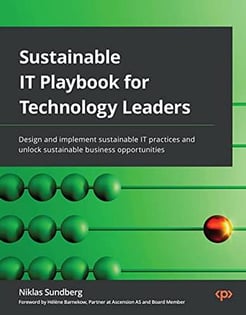“We are the first generation that can end poverty, the last that can end climate change”
– Former UN Secretary-General Ban Ki-moon
In August 2020, during the global COVID-19 pandemic, I assumed a new role as Chief Information Officer (CIO) at a global industrial manufacturing company in Stockholm, Sweden. I knew that I was in for a tremendous challenge and exciting journey simultaneously.
The world as we knew it had changed dramatically, where a significant part of our global workforce was working from home, and scientists were still scrambling for a vaccine to curb the pandemic. As I entered my new role, I was determined not only to solve the expectations that were put on me in the role but also to “use the power of business as a platform for change”, as Salesforce’s altruistic founder and CEO Mark Benioff has famously put it.
 Not only was I determined, together with my team, to over-deliver on my CIO remit, but also to make sustainable IT an integral part of our overall IT strategy, and weave sustainability into our guiding principle and decisions that we would make from here on out towards a sustainable future, a net zero future.
Not only was I determined, together with my team, to over-deliver on my CIO remit, but also to make sustainable IT an integral part of our overall IT strategy, and weave sustainability into our guiding principle and decisions that we would make from here on out towards a sustainable future, a net zero future.
The climate crisis, in combination with the current social crisis across multiple regions, such as emigration, and racial and ethnically driven conflicts, is humanity’s most significant challenge to overcome. We need to halve our greenhouse gas emissions by 2030 to stay in the 1.5°C degrees safe zone, and we need to peel back the consumption of Earth’s natural resources drastically. We are currently running at a pace of consuming 1.75 of Earth’s resources, which means it takes the Earth 1.75 months to regenerate what has been taken out each month. We have a finite number of resources on this Earth, and we must look after them.
Sustainability in IT, sustainability by IT, and IT for society
As ESG (environmental, social and governance) has become a mainstream business issue, corporations are being pushed by mounting regulations and stakeholder pressure to present transparent ESG reporting, assume responsibility for climate change, and deal with it holistically across the entire company. IT is no exception. Technology leaders are tasked with shining a light on the environmental and social impact of IT and taking tangible steps towards a sustainable IT practice. On top of running your environment securely and stably, the ask is to embed sustainability into the fabric of the whole IT organization.
IT’s impact is not insignificant. As illustrated in Figure 1, these are three leading examples of IT’s impact on the environment.

Figure 1: leading examples of IT’s impact on the environment
IT is a significant enabler for long-term sustainability efforts and business success. 88% of a company's sustainability-related strategy decisions are influenced by IT. (Letemple and Craven 2021) Sustainable IT or Green IT has many different meanings, depending on whether you are a manufacturer, manager, or technology user. In the simplest definition, Sustainable IT is manufacturing, managing, using, and disposing of information technology to meet the present needs without compromising the ability of future generations to meet their own needs. It is also necessary to differentiate sustainable IT between sustainability of IT, sustainability by IT, and IT for society.

Figure 2: Sustainability in IT, sustainability by IT and IT for society
Let us look at the definitions:
- Sustainability in IT: Sourcing IT products, components, and services that utilize recyclables, restorative, or regeneration design. (Méndez-Villamil 2021) Directly impacts your CO2 emission reduction – your "footprint.”
- Sustainability by IT: Using innovation for sustainable business models, use cases, and applications. (Méndez-Villamil 2021) Indirect CO2 emission impact since it is embedded into a process or business function – your “handprint.”
- IT for Society: Your altruistic side where you positively impact your people, community, and society – your “heartprint.”
Sustainability in IT includes anything you use internally to run your enterprise, such as owning data centers, managing cloud providers, developing software, managing the lifecycle of your hardware, optimizing your energy consumption, or managing your e-waste. A few examples of Sustainable IT are illustrated in Figure 3.

Figure 3: Sustainability in IT examples - direct CO2 emission reduction
Sustainability by IT is what you develop for internal and commercial use for your customers, providing a product or solution that targets a specific sustainability need. Sustainable solutions enabled by IT can be applied in various industries. Here the use cases are endless, but in Figure 4, we have outlined nine key areas: carbon emission reporting, sustainable sourcing and manufacturing, eco-friendly transportation, energy-efficient buildings, energy resource management, hybrid-work, eco-friendly travel, development of e-services, and product as a service.

Figure 4: Sustainability by IT - indirect CO2 emission reduction
It is also worth mentioning that the EU has created a Recovery and Resilience Facility that identifies a set of given areas (pillars) for its allocation of Covid Recovery Funds related to environmental sustainability and digitalization. This instrument was created to assist the EU in overcoming the Covid-19 crisis and to emerge more robust and more resilient post-pandemic.
IT for society is your altruistic side, where you positively impact your people, community, and society. There are different ways to positively impact society through IT and technology by donating IT equipment, donating employee time, monetary funding, and running specific initiatives to improve diversity equity and inclusion (DEI). Once again, the use cases are endless, but in Figure 5, we have outlined a few key areas: organizational enablement, social responsibility programs, women in tech, and sustainability hackathons.

Figure 5: IT for society – examples of key focus areas
After reading this, I hope you recognize that there are several tangible steps you can take within your business environment to take action. Although we can achieve tremendous sustainability advancements through technology, we must remember to build our digital infrastructure sustainably. I hope I have inspired and challenged you to start to embed “sustainability by design” as an underlying layer of your overall strategy and execution.

Written by Niklas Sundberg
Niklas Sundberg is CIO of ASSA ABLOY Global Solutions in Stockholm. He is the author of Sustainable IT Playbook for Technology Leaders, which educates, engages and activates other technology leaders to get started with their sustainable IT journey. He is also on the board of directors of SustainableIT.org, a nonprofit organization led by technology executives who seek to advance sustainability around the world through technology leadership.



